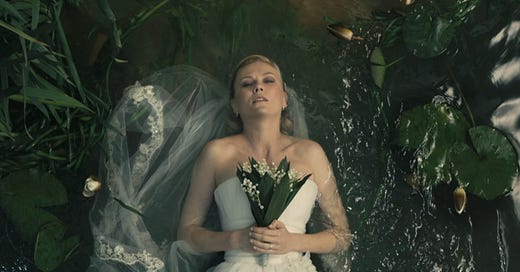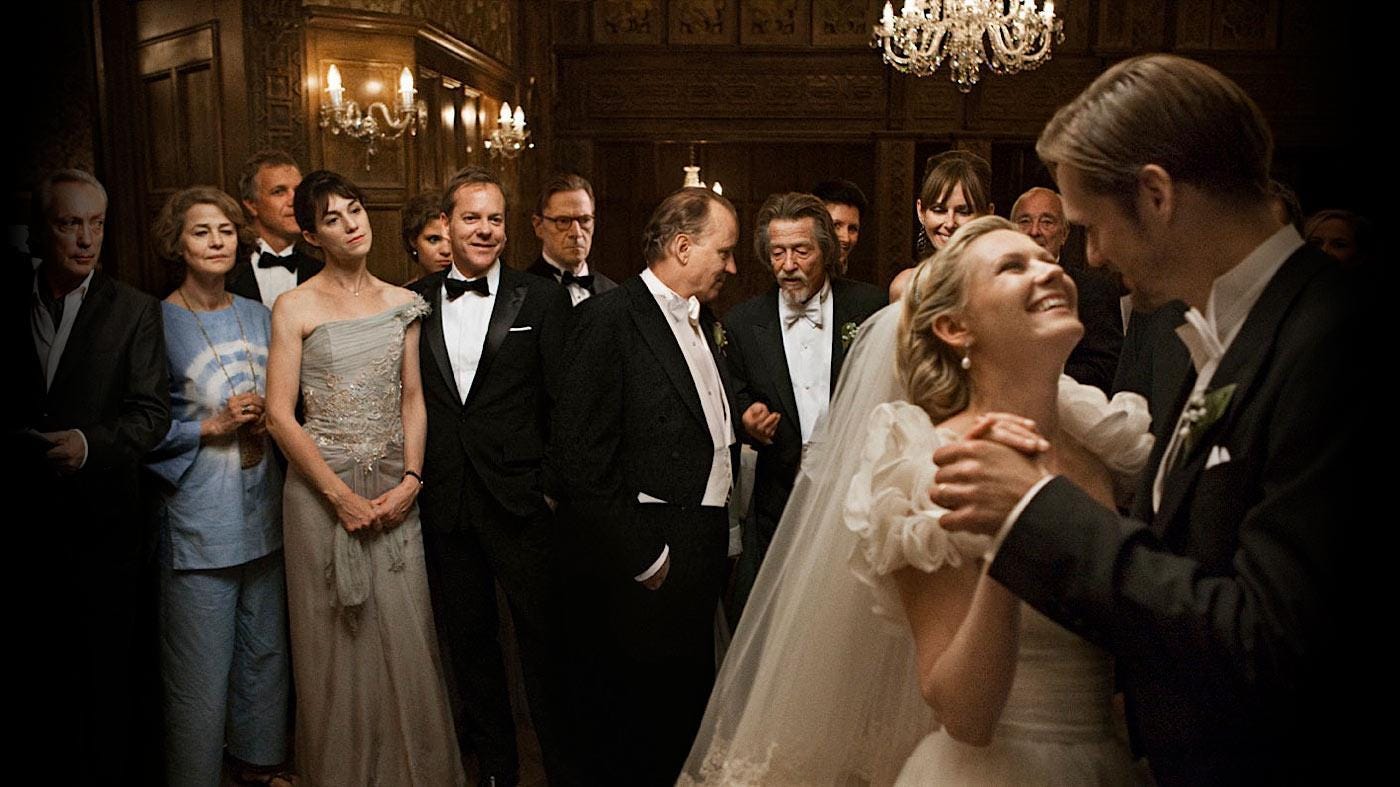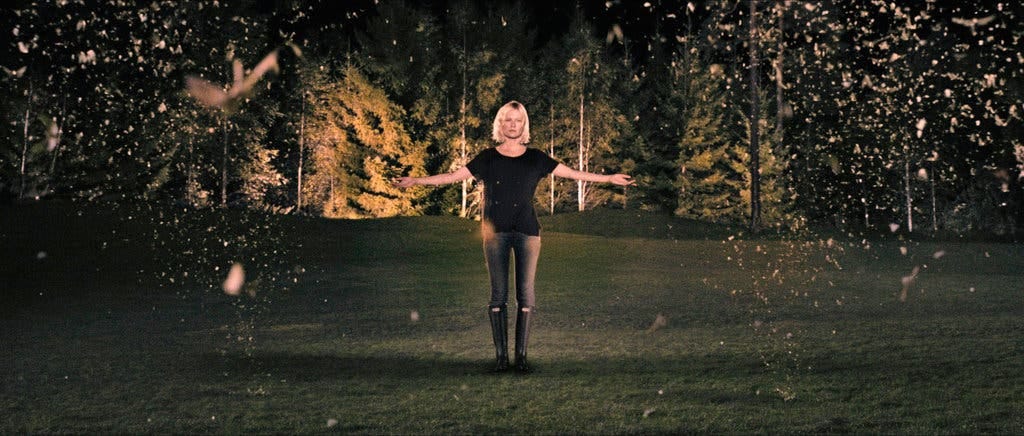'Melancholia' at 10: A Decade of Waiting for the End of the World
Amidst bad press and unforced errors Danish director Lars von Trier released a shockingly heartfelt end-of-the-world story
Melancholia arrived in U.S. theaters ten years ago this month, but it’s taken a while to be able to see it clearly. That’s partly because its Cannes debut in the spring of 2011 had been such a disaster, not because of the film itself but because of director Lars von Trier. During a self-destructive press conference, von Trier, sporting knuckles freshly tattooed with the letters “F-U-C-K,” said the movie “may be crap” and jokingly spoke of harboring Nazi sympathies (though, understandably, many didn’t find the joke funny). Never a filmmaker to let artistic achievement get in the way of a chance to make others cringe, von Trier found himself banned from Cannes for the next seven years.
It’s also partly because Melancholia is so disarmingly raw, a depiction of depression inspired by the director’s own struggles. Von Trier had first gained international attention with the stylistically audacious 1991 film Zentropa. In the years since, he helped launch the punishingly ascetic Dogme 95 movement, blurred the lines between film and theater, and made a down-to-earth musical tragedy and a kind of sexually explicit horror film about grief. His filmography had become a string of provocations and formal experiments, films that, though often stunning, sometimes seem determined in keeping their themes at arms’ length. Melancholia, however, played like one from the heart. Who could have seen that coming?
The Reveal is a reader-supported newsletter dedicated to bringing you great essays, reviews and conversation about movies (and a little TV). While both free and paid subscriptions are available, please consider a paid subscription to support our long-term sustainability.
Not that Melancholia—a film pushed along by a science fiction narrative and divided neatly in two almost to the exact second—is without formal rigor. But it’s driven by its characters and a narrative that lends itself to emotional complexity, even if it can be summarized in one sentence: as the Earth unexpectedly hurtles toward the previously unknown planet Melancholia, the depressive Justine (Kirsten Dunst) finds herself better equipped to deal with impending doom than her well-adjusted sister Claire (Charlotte Gainsbourg). The experience of depression had been depicted onscreen many times before, but never in a way that turned it on its head and pondered the possibility that depressives have it right and that it's the happy, normal people who are truly misguided.
That doesn’t make Melancholia a pro-depression film. It just makes it deeply, disarmingly empathetic to the experience in a way most depictions of mental illness are not. It captures what BBC film writer Sophie Monks Kaufman calls depression’s “perverse richness as a condition–that people sinking into the quicksand of their own minds and bodies can feel things in extravagant depth. They just often can’t communicate it.”
Anchored to Dunst’s revelatory performance, Melancholia keeps finding ways to convey that perverse richness, and its pitilessness. The film’s first half, subtitled “Part One: Justine,” focuses on Justine’s wedding to Michael (Alexander Skarsgård), an occasion that would seem to herald nothing but blue skies and boundless horizons. It even doubles as a moment of professional success when Justine’s boss Jack (Stellan Skarsgård) chooses the reception to announce Justine’s promotion. Though she arrives smiling, over the course of the night Justine finds a way to undo it all, ending her career and marriage with one action. Her descent has a trigger in the form of a bitter exchange between her estranged parents, high-living father Dexter (John Hurt) and acerbic mother Gaby (Charlotte Rampling), that causes Justine’s face to drop and body to slump. But the moment seems more like a catalyst than a cause. This was going to happen. It was always a question of when.
For Claire and her husband John (Kiefer Sutherland), the return of Justine’s depression comes as no surprise. They’ve been here before. Even Michael, though puzzled, isn’t taken aback by Justine’s darkening mood, at least until that mood leads to actions she can’t undo. Melancholia provides little in the way of concrete backstory beyond fleeting details yet manages to suggest a lot of history over this first half, during which Claire becomes a kind of black hole at the center of a feast alive with action and overflowing with well wishes and high spirits she can’t share.
Set some time in the wedding’s aftermath, “Part Two: Claire,” is, by contrast, quiet—at least for a time. An astronomical anomaly glimpsed by Justine on her wedding night but dismissed by others has been revealed as a rogue planet headed in the direction of Earth. Though scientists have offered assurances of a harmless flyby, Claire has become unnerved, seeking out alternate theories online against John’s advice (even as, behind her back, her husband shores up supplies in case of a disaster). All the while, Justine continues to haunt the margins of the rolling estate (complete with, as John frequently points out, an 18-hole golf course) that Claire and John share with their young son Leo (Cameron Spurr), perking up as doomsday starts to look more probable. In one of the film’s most striking images, Justine contentedly bathes nude in the glow of the approaching Melancholia, deriving a kind of fulfillment in the promise of her imminent destruction.
It’s an image of awful beauty, horrifying in its implications but honest in suggesting the totality of the emotions that have enveloped Justine. Though such a moment risks valorizing or eroticizing depression, that’s ultimately not the effect. Instead, its matter-of-factness is what makes it powerful. Of course the end of the world lets her come into her own.
In playing the role, Dunst drew on her own struggles with depression. Though she avoided discussing details of her own life in interviews, Dunst spoke frankly when Time Out asked her about the challenges of depicting depression. “It can be boring,” she said. “When people are depressed, you sleep a lot. It’s hard to make that cinematic and interesting, when someone’s not doing anything, but have an anxiety feeling underneath the whole thing, and to smile but have those glazed-over, out-of-it eyes. That was a big thing for Lars, what that looks like.” Dunst captures that look when we first see her in the stylized opening sequence set to Wagner’s overture from Tristan und Isolde, a striking combination of image and music whose tone carries over through the rest of the film.
The film has similarly lingered. Turning up on many best of the decade lists at the end of the ’10s, it now looks likely to be remembered as von Trier’s signature work. The two-part Nymphomaniac followed in 2013 (forming, with Antichrist and Melancholia what von Trier has called a “depression trilogy”), and Von Trier released The House that Jack Built in 2018. These, respectively, used sex and violence to explore the same dark terrain as Melancholia, but to lesser effect, despite containing remarkable moments. What might have looked like von Trier simplifying his vision for the masses (relatively speaking) in 2011 now looks like an artist choosing to speak clearly and directly.
Melancholia has also been made unnervingly relevant by the times. In “The Melancholia Postulate,” a 2020 piece for The Atlantic, Mallika Rao writes of seeing Justine in the experiences of a friend who found a “strange peace” as the pandemic spread. “For a chronically uneasy person,” Rao writes, “global calamity can, oddly, engender companionship: Everyone suddenly feels the way you always have.” Beyond the pandemic, the past half decade—marked uncertainty, cultural recidivism, crossed boundaries, and the threat of chaos—has exposed many of us as Johns and Claires, people who had assumed that nothing truly bad could ever happen to us because nothing truly bad ever had, that the Earth would put up with the damage we inflicted on it for at least the length of our lifetimes, and that the institutions and values we were taught were eternal would stay that way. The world might not be ending, at least not in a fiery, Wagner-scored collision, but it’s dangerous to ignore the possibility of a slower kind falling apart.
Melancholia works, however, as a more intimate metaphor. The film refuses to let viewers look away from Justine, depicting depression as real, heavy, and without logic. It’s uncomfortable in its fatalism, but that also makes it true to her experience. When Justine says “The Earth is evil. We don’t need to grieve for it,” neither Dunst’s performance nor von Trier’s camera treat the moment as anything but a character stating a fact as she sees it. She can’t see it any other way.
That doesn’t mean she’s right. I’d add, drawing from my own experience, that if you’re down and feel like you need therapy, you should probably seek it out. And if you feel like therapy won’t help, you should definitely seek it out. But such practical approaches are for life. Art has no obligations to depict happiness or offer comfort, much less solutions. In imagining a world in which such recourses couldn’t possibly matter, in which the end truly is nigh and the coming void renders everything as meaningless as the darkest corners of our imagination, in which despair—usually the most private, inaccessible of emotions—becomes a global condition, von Trier’s sends an unsettlingly mesmerizing light out into the void.







Wonderful piece! It feels weird to say this because the movie is only 10 years old, but it's my favorite film of all time. I remember being so shaken by it the first time I watched it, and though rewatches have dulled that raw feeling a little bit, the viewing experience never stops being engrossing any. People mainly focus on it as a film about depression, but I've always found the Claire section to be such a great depiction of anxiety. In general, I love the way the two halves of the film almost talk to each other. The role reversal that the sisters undergo of who is the caretaker and who is being cared for by the end is just so incredibly moving.
This is a one timer for me, I learned a great deal about my own depression through seeing someone else suffer through the symptoms on film and for that I will always appreciate it (from a distance).